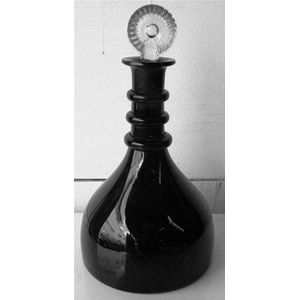Georgian Amethyst Decanter, c1795-1810
A Georgian large amethyst colour three ring decanter with ground pontil mark c1795-1810
You must be a subscriber, and be logged in to view price and dealer details.
Subscribe Now to view actual auction price for this item
When you subscribe, you have the option of setting the currency in which to display prices to $Au, $US, $NZ or Stg.
This item has been sold, and the description, image and price are for reference purposes only.
- Georgian - As an English stylistic period, Georgian is usually taken to cover the period from George I (1714) to the Regency of Prince George (1811-20), although the period from 1800 to 1830 is sometimes designated as the Regency period. During the Georgian period the great English cabinetmakers and designers such as Chippendale, Hepplewhite, Adam Sheraton etc., were all active.
Therefore there isn't a single 'Georgian style' as such and to say something is 'Georgian', usually means it was made between 1714 and 1830. This assumes we discount George V and George VI, both being from the 20th century.
The styles popular at the time of each reign were:
George I (1714-1727) saw out the last years of the Baroque period.
George II (1727-1760) reigned during the Rococo period.
George III (1760-1820) saw the last gasp of the Rococo, all of the early Neo-Classic 'Adam style' and most of the later neo-Classic 'Regency style'.
George IV (Prince Regent 1820-1830)encompassed the last of the 'Regency' style.
William IV's reign (1830-1837) was something of a no man's land (stylistically) and he wasn't a 'George' anyway. He covered the last glimmerings of 'Regency' and the start of the 'Victorian' style. - Pontil Mark - A pontil mark, also known as a pontil scar, is a distinctive mark or scar found on the base of certain types of glass. It is a remnant of the glassblowing process and is particularly associated with handcrafted items made prior to the widespread use of automated manufacturing.
The pontil mark is created during the final stages of production. After the glassblower has shaped and formed the glass object, it is removed from the blowing iron. At this point, the glass object is often attached to a solid rod called a pontil rod or punty for further shaping, finishing, or attaching additional components. The attachment point is typically at the base of the object.
Once the glass item is complete, it is detached from the pontil rod, leaving behind a mark or scar on the base. This mark can take various forms, such as a rough or irregular surface, a concave or slightly recessed area, or a small circular scar. The presence of a pontil mark indicates that the item was handcrafted rather than mass-produced.
Collectors and historians often use pontil marks as clues to determine the age, authenticity, and production methods of glass or ceramic pieces. Different types of pontil marks may suggest different techniques used in the production process. For example, an open pontil mark is one where the scar is left as an exposed, roughened area, while a closed pontil mark occurs when the scar is smoothed or covered in some way. It's important to note that not all handcrafted glass items have pontil marks, as some artisans developed alternative methods for finishing their work. In Edwardian times the pontil mark was oftern ground off leaving a concave circle in the centre of the base of the object.
The use of pontil marks diminished with the advent of industrialization and automated manufacturing processes in the 19th and 20th centuries.
This item has been included into following indexes:
